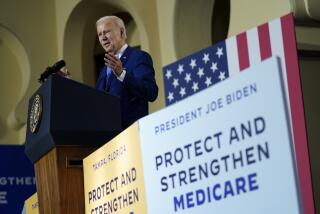Medicare payments for physical therapy have poor prognosis
- Share via
Reporting from Kansas City, Mo. — Glenn McDonald undergoes physical therapy twice a week for a bad back. He’s already had surgery once, and treatment could help him dodge a second date with the scalpel.
“I’ve got a cage in my back,” said McDonald, 65, referring to a stabilizing metal implant in his spine. “The therapy has been more than helpful.”
McDonald’s treatments are paid for, in part, by Medicare, the nation’s health insurance for seniors.
But because of a little-known provision in the law and Washington’s stalemate over healthcare, McDonald -- and more than half a million patients like him across the country -- may soon see an end to Medicare payments for their treatments.
That means he’ll have to pay for the sessions himself, hope other insurance picks up the tab, go to a hospital for help, or simply stop getting treatment for his back.
“It creates stress,” said McDonald, of Grandview, Mo. “I’ve already gone through a quintuple bypass.”
Congress installed the hard cap after learning that outpatient therapy costs were soaring at twice the growth of other Medicare services. And some therapy providers reportedly were charging exorbitant fees, further threatening the financial health of Medicare.
“Medicare payments for outpatient therapy are still rising significantly,” the Government Accountability Office found in late 2005, “and increases in improper payments . . . continue.”
Medicare patients are in this fix because in 1997 Congress set a hard cap on Medicare payments for physical therapy at clinics, nursing homes and doctors’ offices -- anywhere outside a hospital.
The cap did not apply to diagnoses such as multiple sclerosis, joint replacement and “spinal stenosis of the lumbar region” -- a seriously bad back. Those diseases and dozens of other common maladies were automatically exempted from the cap to avoid angering hundreds of thousands of patients.
Until this year. On Jan. 1, the automatic exemption process ended and the hard cap -- $1,860 in payments per year, no exceptions -- took effect.
“You’re talking 15, maybe 20 visits that would max out that cap,” said Frank Ferrantelle, owner of Northland Physical Therapy & Rehabilitation Services in Kansas City.
Both the Senate and House healthcare bills address the issue, but they remain in limbo. Stand-alone repeals of the therapy cap also are stuck in the legislative process.
But Robert Moffit, director of the Center for Health Policy Studies for the Heritage Foundation, noted that Congress has repeatedly cracked down on Medicare spending, only to change the rules after pressure from interest groups -- leading to higher taxes and Medicare’s potential bankruptcy.
“They end up each year preventing their handiwork from actually going into effect,” Moffit said. “Taxpayers have got to understand this.”
But Congress seems likely to address the issue, in part because of patients such as McDonald.
He pays a Medicare premium, he said, and still pays Medicare taxes. He’d like something for his money.
“If the government keeps going the way it’s going,” the computer operator said, “I’ll never be able to retire.”
Helling writes for the Kansas City Star.
More to Read
Sign up for Essential California
The most important California stories and recommendations in your inbox every morning.
You may occasionally receive promotional content from the Los Angeles Times.













